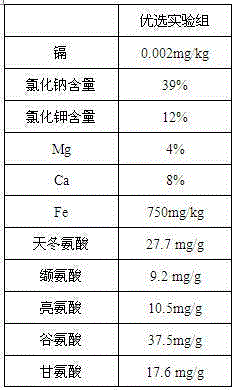Method for planting suaeda salsa at medium-low-cadmium saline-alkaline land and for extracting plant salt
A technology of Suaeda salsa and saline-alkali land, which is applied in the field of plant salt extraction, can solve the problems of insufficient development and utilization, self-destruction of Suaeda salsa, etc., to increase air permeability and water-holding pores, reduce soil pH, and reduce soil The effect of salt content
- Summary
- Abstract
- Description
- Claims
- Application Information
AI Technical Summary
Problems solved by technology
Method used
Image
Examples
Embodiment 1
[0034] Example 1 A method for planting Suaeda salsa in medium-low cadmium saline-alkali land and extracting plant salt
[0035] (1) Selection of saline-alkali land
[0036] The pH of the soil is 8.6-8.8, the salt content of the soil is 3.6-4.3%, the cadmium content of the soil is 4mg / kg, the air-permeable pores of the soil are 4-5%, the water-holding pores of the soil are 14-15%, and the organic matter content of the soil is It is 4.1-4.2g / kg.
[0037] (2) Improvement of saline-alkali land
[0038] Apply soil amendments to improve saline-alkali land.
[0039] The mass ratio of each component of the improver is: 88-92 parts of desulfurized gypsum, 15-18 parts of fulvic acid, 1-3 parts of straw,
[0040] 2-6 parts of medical stone, 1-3 parts of bagasse, 3-6 parts of fly ash, 3-8 parts of bean cake, 2-3 parts of hawthorn powder, 0.5-0.8 parts of water retaining agent, ammonium lauryl alcohol ethoxylate 0.6-0.9 parts, 10-16 parts of starch-acrylonitrile, 15-18 parts of ho...
Embodiment 2
[0080] Example 2 Univariate analysis of interplanting ratio of Amaranthus retroflexus and Elymus chinensis
[0081] Adopt the method of the selection of saline-alkali land in embodiment 1, saline-alkali land improvement, cadmium adsorption process in soil, change the interplanting ratio of Amaranthus retroflexus and Elymus chinensis, keep the planting density of Amaranthus retroflexus and Elymus reincarnation as 10 * 40 cm, see Table 1.
[0082] Table 1 Univariate analysis of interplanting ratio of Amaranthus retroflexus and Elymus chinensis
[0083]
[0084] The interplanting ratio is 4:3, that is, for every 4 rows of Amaranthus retroflexus, 3 rows of Elymus reintroduced should be planted;
[0085] The rest of the interspecies ratios follow the above explanations.
Embodiment 10
[0086] Example 10 Univariate Analysis of Planting Density of Amaranth and Elymus
[0087] Adopt the selection of saline-alkali land in embodiment 1, saline-alkali land improvement, the method for the cadmium adsorption treatment in soil, change the planting density of Amaranthus retroflexus and Elymus chinensis, keep the interplanting ratio of Amaranthus retroflexus and Elymus reincarnation as 4:1 , see Table 2.
[0088] Table 2 Univariate analysis of planting density of Amaranthus retroflexus and Elymus chinensis
[0089]
PUM
| Property | Measurement | Unit |
|---|---|---|
| Length | aaaaa | aaaaa |
| Particle size | aaaaa | aaaaa |
| Particle size | aaaaa | aaaaa |
Abstract
Description
Claims
Application Information
 Login to View More
Login to View More - R&D
- Intellectual Property
- Life Sciences
- Materials
- Tech Scout
- Unparalleled Data Quality
- Higher Quality Content
- 60% Fewer Hallucinations
Browse by: Latest US Patents, China's latest patents, Technical Efficacy Thesaurus, Application Domain, Technology Topic, Popular Technical Reports.
© 2025 PatSnap. All rights reserved.Legal|Privacy policy|Modern Slavery Act Transparency Statement|Sitemap|About US| Contact US: help@patsnap.com



